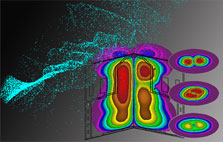 Introduction
Introduction
Plasma Science is the study of ionized gas phenomena. Plasma Science is highly interdisciplinary in that it seeks an understanding of plasma occurrence or interaction in a multitude of environments ranging from space to wafer processing to biological systems. It, therefore, combines plasma physics with fields as diverse as chemistry, atomic physics, aerospace science, and even biology. The fact that ionized gases exist and can be produced in so many different environments naturally leads one to speculate on harnessing such interactions for technological purposes. The beauty of such plasma systems in such diverse environments also leads one to seek understanding of such phenomena for purely academic appreciation. Such appreciation and better understanding also naturally lead to application. The goal of the Plasma Science and Technology Laboratory is to obtain a better understanding of plasma science phenomena leading to the conversion of that understanding to technological application. Specifically, we actively pursue plasma science research topics in four primary areas:
- Space Propulsion
- Environmental Hazard Mitigation
- Aerospace Sciences and
- Energy Conversion
Research Focus Areas
- Space Propulsion
- Engine lifetime Addressing failure modes
- Engine efficiency Plasma source development
- Environmental Hazard Mitigation
- Terrestrial
- Space
- Aerospace
- Hypersonic plasma
- Plasma actuators
- Energy Conversion
- MHD plasma seeding
- Thermionic energy converters
Research efforts are primarily experimental in nature with the goal being to develop a concrete understanding. The experimental data form the foundation of observational knowledge from which theory can be developed and tested, ultimately leading to a reasonably complete understanding.
Guiding philosophy: To understand and utilize plasma science and technology for the benefit of all, here and beyond
